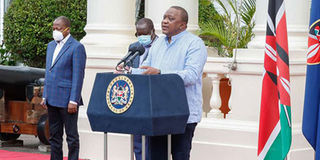Crisis team should share its plan to restore normalcy

President Uhuru Kenyatta addresses the nation concerning a plan to revive the economy, at State House on May 23, 2020. PHOTO | PSCU
What you need to know:
- If the pattern holds, there is little likelihood that the nationwide curfew will be lifted on June 6 when the next review is expected.
- Kenyans want to go on with life under the new normal and that new normal is certainly not a lockdown whose end is seemingly not even being contemplated.
The apex team coordinating the government response to the Covid-19 pandemic should provide a more comprehensive advisory on how long restrictions put in place since March 15 will start easing off for people’s lives to regain some normalcy.
While useful, the daily tally of cases confirmed positive, healed or dead, is adding very little value to millions whose lives have been upended.
After the first Covid-19 case in Kenya was confirmed on March 12, some benign restrictions (like suspension of prison visits) were imposed alongside comprehensive health and sanitation guidelines to protect people against infection.
More robust restrictions that closed learning in all institutions were imposed on March 15, when two more cases were confirmed.
Alarmed by what it saw as a lackadaisical response to its exhortations to wananchi to stay at home unless there was a compelling reason to step out, the government imposed a nationwide night curfew on March 27.
Infections had risen to more than 30 and two deaths had been reported. Flights into and out of the country were suspended and borders partially closed.
That curfew was extended on April 25 as confirmed cases topped 340, deaths increased and screening was ramped up.
The government also started isolating hotspots for even tougher restrictions and placed Nairobi, Kilifi, Mombasa, Kwale and Mandera counties under lockdown.
CASES RISE
Later, it was to further isolate Eastleigh (in Nairobi) and Old Town (in Mombasa) and outlaw movement in and out of them.
Comments by Health Cabinet Secretary Mutahi Kagwe on Friday could suggest that Kibera may be heading that way too, which could make similar action probable against other congested areas of Nairobi (Dandora, Mathare, Kawangware) and other towns.
The pattern seems clear – observe people’s behaviour and restrict their movement if it is confirmed that they are not observing health guidelines.
What the government may be missing here is that it is not the people that are being hard-headed. Rather, it is the testing that is becoming more aggressive.
The virus was around before the testing started and continues to infect where testing has not happened. To many, the more intriguing fact is that deaths have been relatively low.
If the pattern holds, there is little likelihood that the nationwide curfew will be lifted on June 6 when the next review is expected.
Infections are not reducing. In fact, Kenya’s top medical health official, Dr Patrick Amoth, on Thursday projected that infections will peak at around 200 cases a day in August or September. That may well mean that the restrictions we are seeing now will still be in place.
BEHAVIOUR CHANGE
To millions of people, that thought is untenable after the recent partial reopening of restaurants.
They desperately hope the thought is not being contemplated by the National Co-ordination Committee on the Response to the coronavirus Pandemic, chaired by Interior CS Fred Matiang’i.
Rather, they would like the committee that, inter alia, is providing leadership and policy guidance on the overall response to the pandemic, to signal when the suffocating restrictions will start easing off and what the post-Covid-19 picture might look like.
If they disagreed with those that recommended a complete shutdown of the country and a fast reopening thereafter, a posture that seems to suggest an indefinite application of the current (or even tougher) restrictions is equally untenable.
They must have run through multiple simulations of what situations are likely and what responses should apply when.
If we are looking at having a peak of 200 or so new infections daily by August or September, deaths are also going to be within a certain expected range, meaning that whatever freedoms are admissible within those limits should be allowed.
Kenyans want to go on with life under the new normal and that new normal is certainly not a lockdown whose end is seemingly not even being contemplated.
The writer is a former Chief Editor of the Nation Media Group and is now Managing Partner for Blue Crane Global. ([email protected]; @tmshindi





